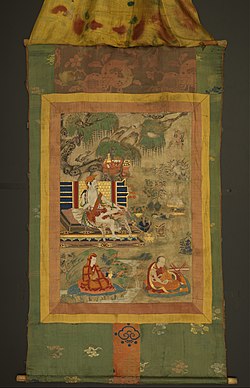
Back Šest nauk Náropy Czech Sechs Yogas des Naropa German Seis yogas de Naropa Spanish Six yogas de Nāropa French ナーローパの六法 Japanese Sześć Jog Naropy Polish Seis yogas de Naropa Portuguese Шесть йог Наропы Russian Naropas sex yogatyper Swedish Шість йог Наропи Ukrainian

The Six Dharmas of Nāropa (Wylie: na ro'i chos drug, Skt. ṣaḍdharma, "Naro's six doctrines" or "six teachings") are a set of advanced Tibetan Buddhist tantric practices compiled by the Indian mahasiddhas Tilopa and Nāropa (1016–1100 CE) and passed on to the Tibetan translator-yogi Marpa Lotsawa (c. 1012).[1]
Another name for the six Dharmas is "the oral instruction transmission for achieving liberation in the bardo," or "the Bardo Trang-dol system". Bardo here, refers to the three bardos of waking, sleep and dying.[2] They are also referred to as "the path of means" (thabs lam) in Kagyu literature.[3] They are also sometimes called the Six Yogas of Nāropa (though not in the traditional literature which never uses the term ṣaḍaṅga-yoga or sbyor-drug).[1]
The six dharmas are a collection of tantric Buddhist completion stage practices drawn from the Buddhist tantras. They are intended to lead to Buddhahood in an accelerated manner. They traditionally require tantric initiation and personal instruction through working with a tantric guru as well as various preliminary practices. The six dharmas work with the subtle body, particularly through the generation of inner heat (tummo) energy.
The six dharmas are a main practice of the Kagyu school (and was originally unique to that school) and key Kagyu figures such as Milarepa, Gampopa, Phagmo Drugpa and Jigten Sumgon taught and practiced these dharmas.[4] They are also taught in Gelug, where they were introduced by Je Tsongkhapa, who received the lineage through his Kagyu teachers.